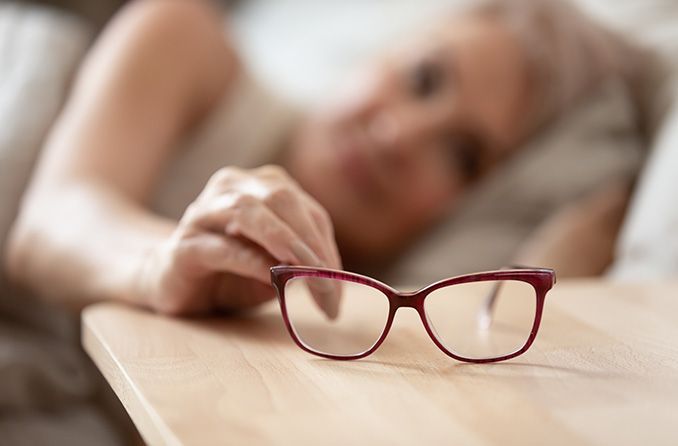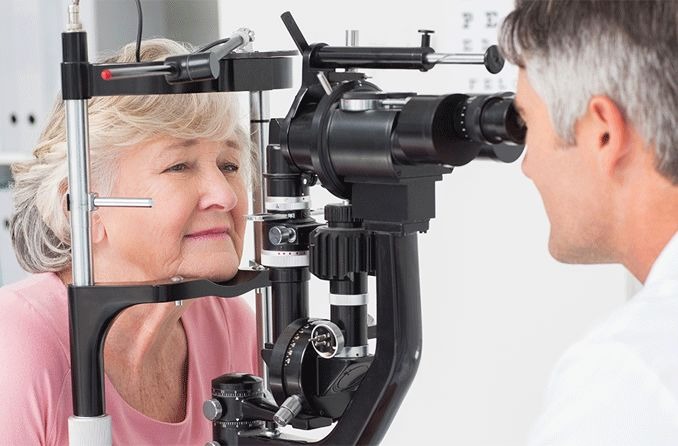A-B | C-D | E-H | I-L | M-O | P | Q-S | T-Z
Abbe value A measure of the tendency of an eyeglass lens material to cause chromatic aberration, which is an optical distortion that causes colored halos or fringes around lights or blurred vision, especially when looking through the periphery of the lens. The lower the Abbe number, the more likely chromatic aberration will be noticeable.
aberrometer A device that can identify common and more obscure vision errors by measuring the way light waves travel through the eye's optical system.
ablation Removal. In vision, ablation refers to the surgical removal of eye tissue to correct a refractive error such as myopia. For example, in laser procedures such as LASIK and PRK, the excimer laser ablates, or removes, tissue from the cornea.
accommodation Eye's ability to automatically change focus from seeing at one distance to seeing at another.
accommodation disorder Accommodation refers to the eye's ability to automatically change focus from seeing at a distance to seeing at near. Accommodation disorders have a variety of causes. Symptoms include blurred vision, double vision, eye strain, headache, fatigue and difficulty concentrating (particularly while reading). Presbyopia is an accommodation disorder that affects everyone if they become old enough, since its causes relate to the aging of the eyes.
acetate Type of plastic often used in eyeglass frames.
acrodermatitis enteropathica Rare inherited condition characterized by dermatitis, hair loss, diarrhea and zinc deficiency. The most common eye symptom is light sensitivity, but conjunctivitis and other symptoms may also be present.
AK (astigmatic keratotomy) Procedure in which a surgeon cuts the cornea so that it is more spherical when it heals, thus reducing astigmatism.
albinism Condition where a person or animal lacks pigment. Albinos' eyes often have very light blue or pink irises and a pink pupil (due to lack of pigment inside the back of the eye). Visual symptoms include light sensitivity, nystagmus, blurred vision, vision loss and strabismus.
allergen Any substance (such as pollen, mold, dust or animal dander) that causes allergy symptoms in sensitive individuals.
allergy Reaction of the body's immune system to a foreign substance (e.g., pollen, animal dander, etc.). When the eyes are affected, the most common symptoms are redness, itching, chemosis, tearing, swollen eyelids and stickiness. Read more about allergies and the eyes.
ALS (Lou Gehrig's disease) Amyotrophic lateral sclerosis is a disease that causes degeneration of neurons in the brain stem and spinal cord. Voluntary muscles atrophy and eventually become paralyzed.
amaurosis fugax Sudden and usually temporary vision loss caused by an "eye stroke." When a clot or blockage disrupts blood flow to the eye, symptoms can include curtain-like darkness, usually in just one eye.
amblyopia Also called lazy eye. Undeveloped central vision in one eye that leads to the use of the other eye as the dominant eye. Strabismus is the leading cause, followed by anisometropia. There are no symptoms. The patient may be found squinting and closing one eye to see; there may be unrecognized blurred vision in one eye and vision loss. Read more about amblyopia (lazy eye).
AMD or ARMD (age-related macular degeneration) Disorder characterized by the gradual loss of central vision due to a damaged macula (which is made up of retinal cones necessary for sight). Read more about macular degeneration.
angiogenesis The formation of new blood vessels in the body.
aniridia Absent or partially absent iris, typically congenital. Additional symptoms include poor vision and photophobia.
anisocoria Unequal pupil size. Causes include glaucoma, head or eye trauma, an intracranial tumor, infection of the membranes surrounding the brain and previous intraocular surgery. A small percent of the population has unequal-sized pupils naturally (without any known cause). Read more about unequal pupil sizes.
anisometropia Condition where the eyes have a significantly different refractive power from each other, so the prescription required for good vision will be different for each eye.
anophthalmos Absence of one or both eyes. Anophthalmos may be congenital or due to trauma, infection or other causes. Symptoms include reduced depth perception and peripheral vision.
ANSI The American National Standards Institute is a private, non-profit organization that coordinates efforts to develop standards for manufacturing many different products, including eyeglass lenses. For example, certain ANSI standards define acceptable levels of impact resistance for safety eyewear.
ANSI Z87.1-2003 Standard The American National Standards Institute's Practice for Occupational and Educational Eye and Face Protection; eyewear that meets this standard is considered safer than eyewear that does not.
anterior chamber Part of the eye behind the cornea and in front of the iris and lens.
antibody A protein activated by the body's immune system that fights infection, toxins and other foreign substances.
antioxidant Substance that inhibits oxidation and can guard the body from damaging effects of free radicals. Molecules with one or more unpaired electrons, free radicals can destroy cells and play a role in many diseases. Antioxidant vitamins include B, C and beta-carotene. Antioxidants may help prevent macular degeneration and other eye diseases; many studies are in progress.
anti-reflective coating (AR coating) Thin layer(s) applied to a lens to reduce the amount of reflected light and glare that reaches the eye. Read more about anti-reflective lenses and other eyeglass lens coatings.
apheresis A process in which blood is drawn outside the body, certain compounds are removed, and the blood is returned to the body. The technique has various applications, including: harvesting of needed components such as plasma or white blood cells; and removing harmful components such as large proteins, in order to treat the dry form of age-related macular degeneration (AMD).
aqueous humor The clear, watery fluid that fills the space between the cornea and lens of the eye. The aqueous humor (or aqueous) is produced by the ciliary body behind the iris and drains from the anterior chamber of the eye through the trabecular meshwork Failure of the aqueous humor to drain properly from the eye increases intraocular pressure (IOP) and can lead to glaucoma.
Argyll Robertson pupil Small, irregular pupil, usually caused by syphilis. Argyll Robertson pupils do not respond to light.
aspheric Not quite spherical. Aspheric eyeglass lenses are popular among people who have strong prescriptions because they are thin and lightweight, and reduce distortion and eye magnification. Aspheric contact lenses can work as a multifocal, or to correct a single-vision problem like astigmatism.
asteroid hyalosis A benign condition that creates suspended particles within the eye's interior, observable by an eye doctor during an exam. Floaters are not usually associated. These yellowish particles made of fats (lipids) rarely interfere with vision or cause symptoms. The particles move within the eye's gel-like vitreous and resemble stars at night. The condition is not well understood, but appears associated with aging.
astigmatism A refractive error where objects at all distances have a distorted appearance ("streaked" or stretched, with elongated shapes and unequally blurred borders). Symptoms of astigmatism include squinting, eye strain, headaches and reading problems. Read more about astigmatism.
atopy Type of allergy where levels of the antibody immunoglobin E are increased; atopy includes rhinitis, asthma, hay fever and eczema.
aura A sensation experienced before an attack of epileptic seizure, migraine or other disorder. Examples are flashes of light, colored lights, numbness, coldness and even hearing voices.
aviator glasses Glasses with a large, upside-down teardrop shape like the sunglasses that aircraft pilots have worn traditionally; they usually have a metal frame and large, tinted lenses, but they are also available with plastic frames and clear lenses. Often they have a double-bar bridge. They offer a distinctly retro or vintage look.
band keratopathy Opacity of the corneal stroma and Bowman's membrane. Symptoms include vision loss and foreign body sensation.
base curve The main or steepest part of the curve used in the design of a contact lens. Measured in millimeters, the base curve is prescribed to match or complement the curvature of your cornea. The lower the number, the steeper the curve of your cornea.
Bell's palsy See Bell's palsy.
benign essential blepharospasm Neurological disorder causing involuntary muscle contractions, with eyelid muscle spasms.
best corrected visual acuity (BCVA) The best vision you can achieve with correction (such as glasses), as measured on the standard Snellen eye chart. For example, if your uncorrected eyesight is 20/200, but you can see 20/20 with glasses, your BCVA is 20/20.
beta blocker Drug that widens or dilates blood vessels, thus enabling more normal flow of blood. Topical beta blockers applied as eye drops also can lessen fluid production and lower internal eye pressure (intraocular pressure) in eye diseases such as glaucoma to reduce the possibility of optic nerve damage. Beta blockers also are used to control high blood pressure (hypertension). Side effects can include respiratory problems.
beta titanium Titanium alloy. Beta-titanium eyeglass frames are both strong and flexible.
bifocal Lens with one segment for near vision and one segment for far vision. The term "bifocal" can apply to both eyeglass lenses and contact lenses.
binocular vision Ability of both eyes to work together to achieve proper focus, depth perception and range of vision.
biocompatible Able to coexist with living tissues without harming them. For example, artificial lenses are designed to be biocompatible with tissue inside the eye so they won't cause a toxic or immunilogical response that would harm the eye.
bioptic telescopic lenses (BTL) Devices attached to glasses that provide extreme magnification, typically used for driving. For people with low vision who are qualified, telescopic lenses are attached above the driver's line of sight to help magnify objects such as road signs.
blepharitis Inflammation of the eyelid(s), typically around the eyelashes. Various types of dermatitis, rosacea and allergic reactions can cause blepharitis. Symptoms include a red or pink eyelid, crusty lid or lashes, burning, foreign body sensation, eye or eyelid pain or discomfort, dry eyelid, dry eye, eyelash loss, grittiness, stickiness, eyelid swelling and tearing. Read more about blepharitis.
blepharochalasis Excessive, drooping eyelid skin caused by recurring swelling. Blepharochalasis typically occurs in young people.
blepharoconjunctivitis Inflammation of the eyelid and conjunctiva. Infections and allergic reactions are among the causes. Symptoms include a red or pink eye, a red or pink eyelid, pain or discomfort of the eye or around the eye, tearing, burning, eye dryness and eye stickiness.
blepharospasm Involuntary increased blinking that progresses to spasms in both eyes. The exact cause is unknown, but doctors believe it to be a central nervous system disorder. It can produce a functional blindness since the patient can't open his or her eyes long enough to function visually.
blue light Found in the light spectrum next to violet, which has the shortest wavelength of visible light. Also known as High Energy Visible (HEV) light, blue light has been linked to eye damage and diseases such as age-related macular degeneration. Read more about blue light.
botulism Serious illness from a toxin produced by Clostridium bacteria (usually Clostridium botulinum). Infant botulism and food-borne botulism are the most common forms in the United States. Symptoms include double vision, blurred vision, drooping eyelids (ptosis), muscle weakness, difficulty speaking, difficulty swallowing, difficulty breathing and nausea.
Bowman's membrane Corneal layer between the epithelium and the stroma.
bridge The part of an eyeglass frame that extends across the nose.











